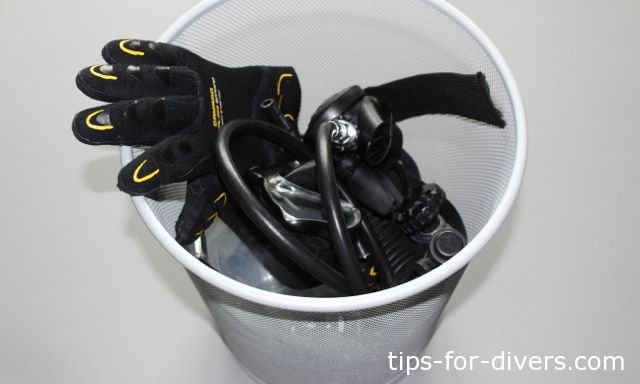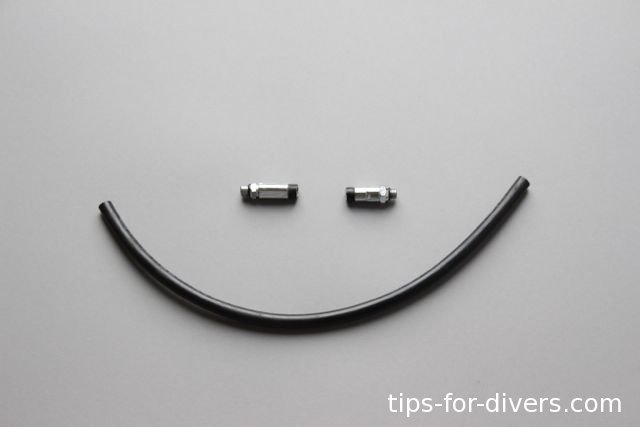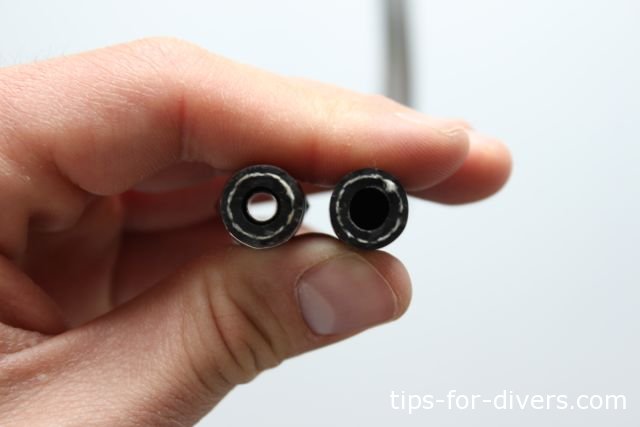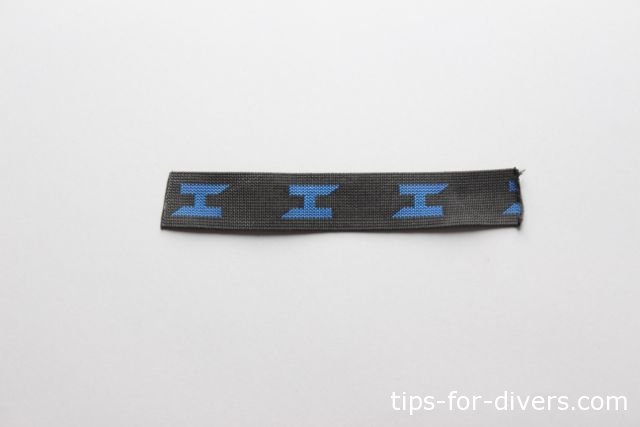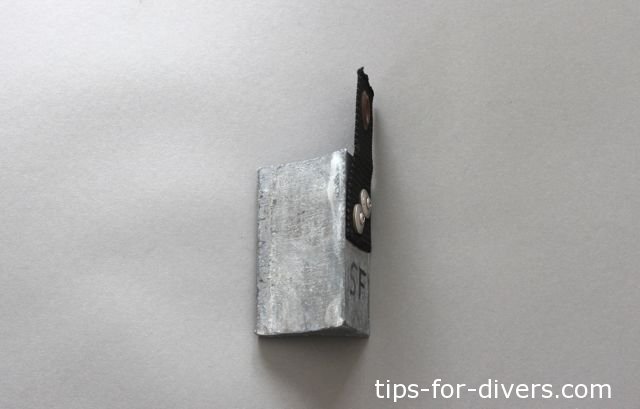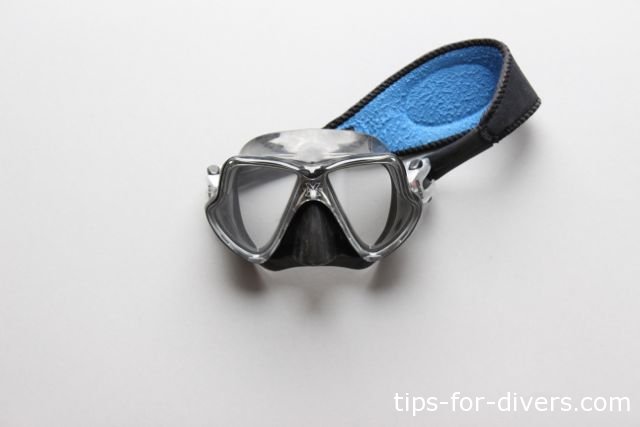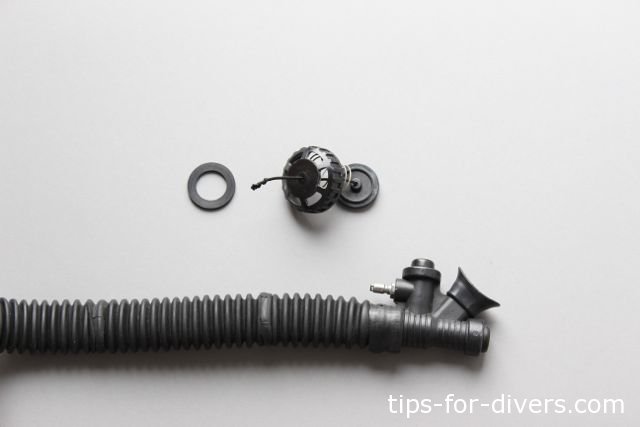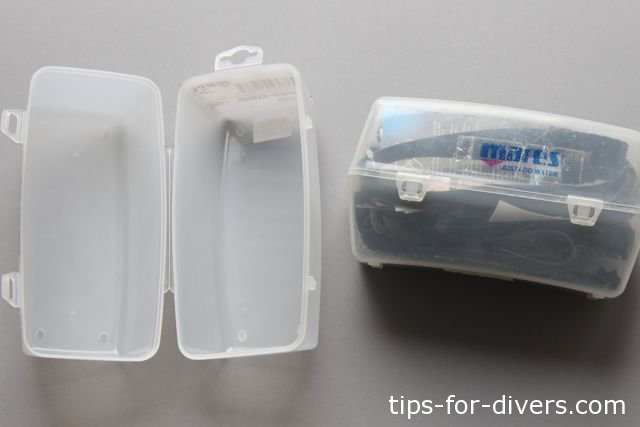In a diver’s life he or she collects quite a bit of scuba-gear. Technical divers collect even more equipment than recreational divers! If a piece of equipment breaks it is normally put in the trash bin, as we do it with other stuff that we use in our daily lifes.
But in this blog post I would like to show you that you can re-use old – or even broken scuba-gear – perfectly for other handicraft work with your scuba-gear.
Tips for Divers is a website for tinkerers! And what does every tinkerer need? Right: “Raw material” and spare parts for his work. Next to a shopping tour in your beloved diving shop you can also gain material out of old scuba equipment.
Objective of this blog post is to show what parts of your scuba-gear can be re-used or recycled and so can still be used for your diving – even if it is in another way than the piece of equipment was designed for.
You could also name this post: The creative re-use of old scuba-gear.
Low Pressure Hose
As a scuba diver your scuba-gear comes along with at least three low pressure hoses: One for your primary regulator, one for your backup regulator and one for the inflator. Every now and then a low pressure hose busts – that’s life! There are at least two ways how a hose can bust: Unspectacular (the rubber coat of the hose has a damage) or spectacular (the hose bursts with a huge bang -hopefully while you are at the surface). In both cases the hose has to be replaced!
But do not put it in the trash bin! There are two ways to re-use the old low pressure hose:
Stage rigging kit made out of a LP hose
The first tip is for all divers that use stage tanks. A low pressure hose is perfect for the “middle part” of a stage rigging kit.
A stage rigging kit is made of rope, two boltsnap carbiners, a metal clamp, textile tape and a rubber hose.
How a stage rigging kit is made you can find here: Article Stage Rigging Kit
Instead of a rubber tube that you buy in a hardware store or dive shop you can easily use a LP hose. You just have to cut off both endings (at the endings the screw threads are attached to the hose). After cutting the endings off you just have to find the right length of the hose for your stage rigging kit and cut it accordingly.
After that, thread the rope through the hose and go on like described in the article “Stage Rigging Kit”.
Leash made out of a LP hose
This tip is also for divers who dive with stages; and in this case with multiple stage tanks! If you dive with three or more stage tanks it is not manageable to store all stage tanks to your left chest and hip-D-rings. Within the DIR philosophy a maximum of two tanks are attached in front of the diver. All the other stage tanks are attached with a so called “Leash”.
Stage tanks 3, 4 etc. are clipped into this Leash. The leash is attached to the left hip D-ring. From there you direct the leash with the tanks over your thigh and between your legs.
I have to admit, this is not the most comfortable way of diving but the stage tanks are stored in quite a good streamlined position.
How to make a leash can be found here: Article How to make a leash
Excursus: Hoses
Talking about hoses: Are the above mentioned tips are also makable with high pressure hoses? Not really. As you can see on the picture above, high pressure hoses have a smaller inner diameter than low pressure hoses. Why? Because high pressure hoses have to handle a higher pressure than LP hoses! Therefore the hose needs more material.
Therefore you have not that much space in a HP hose to run a rope through it.
Neoprene Gloves
Who does not know it? Divers quest for the perfect gloves. Which one is warmer, which one more comfortable and with which can I grab best?
Therefore each diver has a few pairs of gloves at home. Some of them used very often, others not. Neoprene gloves even lose isolation during their live cycle. After a few deep dives you have to replace the gloves and buy some new ones.
For such gloves there are at least to ways to re-use them.
Wrist Warmers made out of old Gloves
If you dive in cold water regularly and use neoprene gloves (no dry gloves) there is an easy way to keep the hands a little warmer. You cut some wrist warmers out of an old pair of gloves.
They are used as some kind of seal to prevent water entering the gloves. And they can even protect the seals of your dry suit.
To say it quit simply, you just have to cut the gloves in two pieces. Cut them right under the thumb. With this cut you remove the fingers from the glove but keep the material that covers wrist and parts of the palm.
How you make these wrist warmers in details can be found here: Article Wrist Warmers for Divers
Neoprene patches
Another option to re-use old neoprene gloves is to use them as a spare part. If you have to repair a leakage in your neoprene suit or dry suit you can use the neoprene of the glove. You just have to cut a piece of material off the glove.
Webbing
Another piece on our list of recycled scuba gear is webbing. Each of you who is diving with a wing and backplate/ harness will have some webbing at home.
The webbing of the harness is too long for most divers. So you have to cut it after adjusting backplate and harness in the right way.
With these webbing you can make a tail weight.
Tail weight made out of a piece of Webbing
All you need to tinker your own tail weight is:
- A piece of webbing
- Weight (lead in form of a “V”)
- A rivet (with hollow punch and hammer)
- Two screws
On one side of the webbing you attach the rivet. On the other side you attach the V-Weight with the two screws to the webbing. That’s it – your self made tail weight.
The tail weight is placed in the lower part of your twin tanks.
Spare parts from broken scuba-gear
Even broken equipment that you cannot use to build something new can be used to gain spare parts! DIR divers dive standardized equipment. Therefore some pieces are used more than others. For instance masks, regulators… If one of these pieces breaks you can get as much spare parts out of it as possible. These spare parts can be used in the future to repair another equipment error.
Mask
A very good example is the mask. My favorite is the Mares X-Vision mask. It fits perfectly to my face. Therefore I do have several of them. Two I take with me for diving. One stays in the car in case a friend forget his’/hers. And one is for training in the pool.
One broken X-Vsion is stored in my tool box (the silicone broke after several years of use). Parts I can still use:
- Lenses
- Frame
- Fastener
Should one of my X-Vision mask break in the future there is a good chance that I have a spare part at home to repair it.
Wings
Even wings have some pieces that can be re-used. Worst case for wings is a broken inner bladder. Small punters can be fixed. But with bigger leaks the wing has to be replaced by a new one! In this case you can re-use a few things of the wing.
For example the inflator or the dump valve.
You can even find more examples of equipment that can be used for your spare part storage:
- Compass: Do you really have to replace the whole broken compass? Or is it enough to change compass capsule or the rose of the compass?
- Broken canister light: Can the torch be re-used? Could I use the canister for other things (like heatable undergarments)?
- Dry suit: The suit’s material is porose: What about the seals? Can they be used again? What about the p-valve? Etc.
As you can see it can be worth to have a look at old or even broken scuba-gear: Many things can be used as spare parts. Or you can even use them for new things (like a LP hose as part of the stage rigging kit).
Even things that every diver knows but that are not used for diving, actually, can be used 🙂
Mask boxes
My favorite example is the mask box. For every mask you will get a box – and be honest: How many masks do you own? And to be honest a second time, who really stows his/her masks in these boxes?
Okay, I did it in the beginning. But nowadays the mask is thrown into my equipment box without it. Result is that I have 5 unused mask boxes at home. So what can be done with them?
Mask boxes – alternative use
Mask boxes are the ideal storage for specific pieces:
- One box is for bicycle tubes. You need these for attaching the backup light to the harness or to fix your neoprene mask strap. So I do have at least two bicycle tubes in storage.
- One box contains mask straps and old fin straps (you never know for what you can use these)
- One box will become a first aid kit within the next few weeks. I would like to carry some stuff that can be useful in case of an (smaller accident) while getting ready for the dive or after the dive (a blog post about that will follow!)
- …
Another very useful way to use a mask box is to store your most important spare parts and tools to repair your scuba equipment. You can easily take this box with you to the dive site or even on vacation.
As you can see the life-cycle of scuba equipment can be extended in many cases! Have a look at your old gear if there is anything you can recycle or re-use or even store as a spare part for future failures.
At the end of the blog post I am really interested in your experience: What did you tinker out of old scuba equipment? Which kind of spare parts are wise to have in your opinion? Just leave a comment below this article! Thanks for reading!

